tags: evolution, speciation, diversification rate, Zosterops, White-eyes, ornithology, birds, molecular phylogeny, South Pacific Islands
The Splendid (Ranongga) White-eye, Zosterops splendidus,
endemic to Ranongga Island in the Solomon Islands archipelago.
This species' home range is smaller than Manhattan Island.
For many decades, the white-eyes (Family: Zosteropidae) were known as the "Great Speciators" in honor of their apparent ability to rapidly give rise to new species while other birds in the same areas showed little or no diversification. But the Great Speciator hypothesis could only ever be indirectly inferred -- until now, that is. According to a paper that was just published by my postdoctoral colleagues, Rob Moyle and Chris Filardi, this group of diminutive birds apparently does evolve faster than any other avian group on earth.
This research -- the result of ten years in the field and five more years in the lab -- was a collaboration between my postdoctoral colleagues, Chris Filardi, a Biodiversity Scientist for the Pacific Programs at the Center for Biodiversity and Conservation at the American Museum of Natural History, and Rob Moyle, an Assistant Professor of Evolutionary Biology and Assistant Curator at the University of Kansas, Catherine Smith, a colleague of mine from graduate school, and the hypothesis co-developer, Jared Diamond, a Professor of Biogeography at the University of California at Los Angeles.
Together, my colleagues collected and studied the enigmatic White-eyes: a group of small olive-green passerines whose common name honors their most characteristic feature; the dramatic ring of tiny white feathers around their eyes, which gives the impression that they are wearing white-framed spectacles. Historically, the Zosteropidae dispersed across a large geographic area throughout the tropics and subtropics, from Asia to sub-Saharan Africa and Oceania, leaving numerous species along the way (Figure A);
Figure A: (left) Chestnut-crested Yuhina, Yuhina everetti [larger view], endemic to Sabah Island, Malaysia. The entire family of Zosteropidae is embedded within this genus (see figure 1). (Right) A Mountain Blackeye, Chlorocharis emiliae [larger view], a monotypic genus that is endemic to Borneo, Indonesia. This genus is embedded within Zosterops.
Images: Rob Moyle.
The mechanism of this rapid radiation remained elusive for 80 years. Yet, so remarkable was the diversification of this lineage that the famous evolutionary biologist, Ernst Mayr, devoted a 1942 paper to exploring this phenomenon, and in 1976, biogeographer Jared Diamond coined the hypothesis name; "The Great Speciators." But how closely related are the white-eyes? How could they form so many distinct species -- often located very close together geographically -- when clearly, their dispersive way of life should aid gene flow and thereby prevent speciation? This conundrum is the Great Speciator Hypothesis's famous paradox.
To test this hypothesis and to gain an understanding of its famous paradox, the team sequenced nuclear and mitochondrial DNA isolated from individuals from 42 species of Zosteropidae and 23 species of the closely-related Timaliidae (Babblers). They analyzed those data to reconstruct evolutionary relationships among white-eyes, to assess their geographic and temporal patterns of diversification, and to determine diversification rates within the Z. [griseotinctus] species complex (Figure 1);
Fig. 1. Phylogenetic and geographic relationships of white-eyes. Tree produced by rate-smoothing the ML phylogeny, calibrated with an age of 560,000 years before present at node 1 based on estimates of island age within the New Georgia Group of the Solomon Archipelago. Thickened branches indicate posterior probability ≥ 0.95 and bootstrap proportion ≥ 70; 2 inferred insertion/deletion events are labeled near the base of the tree. Bold species names indicate members of Z. [griseotinctus] species complex, all of which inhabit the New Georgia Island Group in the Solomon Archipelago except Z. rennellianus, which is endemic to Rennell Island, and the nominate Z. griseotinctus, which inhabits the Louisiade Islands off eastern New Guinea. Colors on map indicate distribution of Yuhina (purple), Clade A (green), and Clade B (orange). Lineage through time plots track the number of extant lineages (ln) for the entire ingroup and within Clade B alone. The time scale at the bottom applies to the LTT plot as well as the phylogeny. The Quaternary (Q) includes the Pleistocene and Holocene epochs. Bird images illustrate general patterns of diversity within the major clades.
As you can see from the phylogenetic tree and the other accompanying data analyses, most of the 100-plus White-eye species evolved very recently and rapidly.
"As we started to compile the data, we were shocked," recalls Moyle. In short, the team found that "White-eye species from across the family's range had strikingly similar genetics, indicating a recent origin and incredibly rapid diversification."
Apparently, the Zosteropidae emerged as a group between 4.46 and 5.57 million years ago, and then radiated explosively into the roughly 80 named species within the genus Zosterops within just the last 2 million years. Based on these data, the team calculated the rate of diversification for Zosterops, and found that it is the fastest known rate of speciation for birds: between 2.24 and 3.16 species per million years.
"White-eyes evolved into dozens of new species extremely fast while simultaneously spreading across much of the hemisphere," Filardi told me last night in a late night phone call.
Only a few other vertebrates in the world are known to have a faster rate of speciation; most notably, the famous cichlid fishes found in lakes of the African Rift Valley, many of which are popular aquarium subjects in the United States. We now know that cichlid diversification occurred to meet the demands of climate shifts and geological changes within their narrow geographic range, while the rapid speciation among white eyes cannot be linked to environmental factors because of their recent hemispheric spread. Why is this particular lineage so adept at giving rise to new species?
"At this geographic scale," Filardi continued, "there is no one thing from the outside that could have made this happen; there is something special about those birds."
The team suggests that intrinsic life history traits of white-eyes actually drive speciation in this lineage. These traits include extreme sociability, the ability to survive in a variety of habitats, and a short time generation time when compared to other birds. Additionally, some species apparently have given up their dispersive lifestyle and "settled down," thereby minimizing gene flow so new species could form.
These data not only support the "Great Speciator" hypothesis but they also explain the famous paradox where some organisms can rapidly give rise new species while simultaneously dispersing over large geographic distances.
"This leaves the question: are the white eyes really special, or have we simply caught them at a special time in their evolution?" Filardi speculated. "That we don't know, but our results indicate that high rates of diversification may have as much to do with a species' 'personality' as they have to do with more classical geographic or geological drivers of speciation."
Malaita White-eye, Zosterops stresemanni [larger view], endemic to Malaita island, in the Solomon Islands archipelago. It is a very drab white-eye, in contrast to the Rannonga species (top).
Image: Rob Moyle.
Using Skype, email, mobile phones and other modern technologies to send documents and data back and forth, Filardi went on to describe this work as a "true collaboration" where he and Moyle discussed and developed their data and ideas together.
"I am delighted to see this molecular evidence supporting ideas that I had only been able to guess at over the last several decades," remarked Diamond, who is very supportive of this collaboration. "I know that Ernst Mayr, if he had still been alive, would have been delighted at this confirmation 78 years after he visited the Solomons."
A scenic photo in the New Georgia Group, Solomon Islands. The high island
is Kolombangara, an extinct volcano.
Seven forms (species?) of white-eyes live in this tiny archipelago.
Sources
R. G. Moyle, C. E. Filardi, C. E. Smith, J. Diamond (2009). Explosive Pleistocene diversification and hemispheric expansion of a "great speciator." Proceedings of the National Academy of Sciences DOI: 10.1073/pnas.0809861105.
My friends and colleagues, Chris Filardi and Rob Moyle, who both are happy to answer your comments and questions in the comments thread.
- Log in to post comments

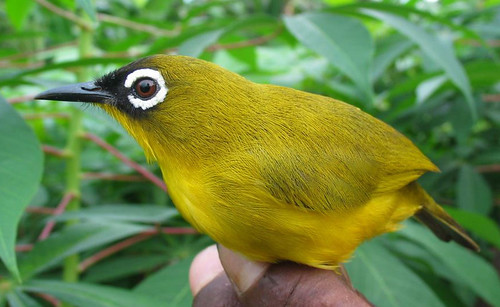
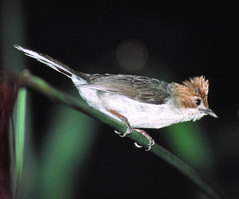
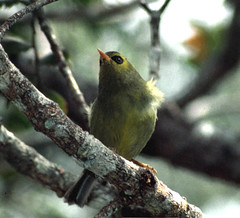
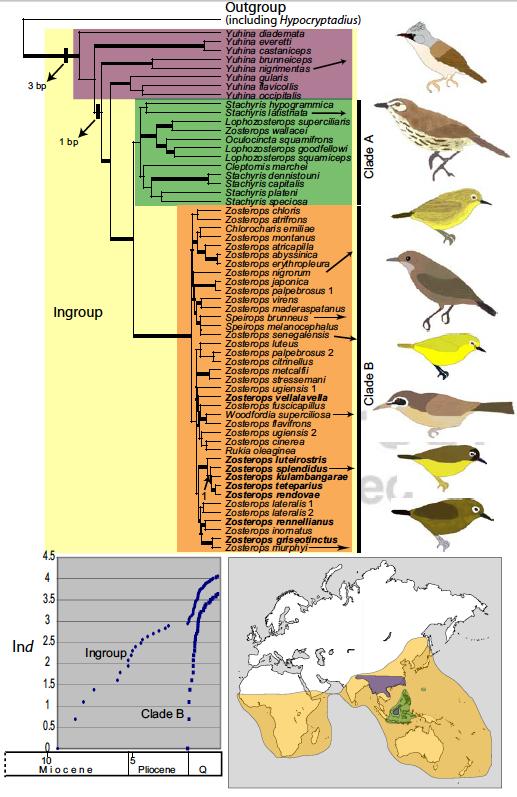
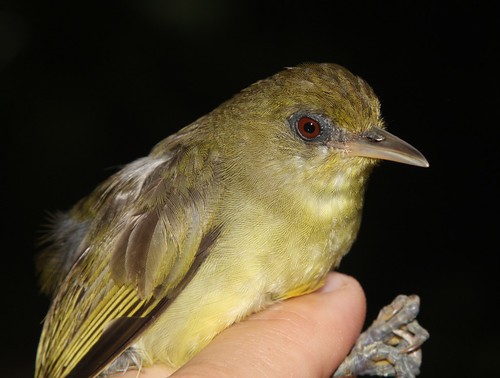
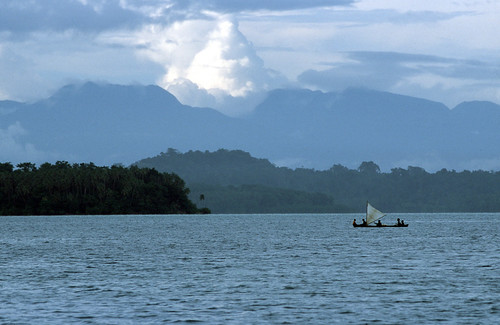

Cool stuff, as always.
There's one thing that's puzzling me. I can see that the white-eye's life history lends itself to radiation, so why did they radiate explosively when they did? Why not earlier? Was there some trigger around 2mya?
That is so cool. Have other bird species had times of greater speciation earlier in their evolutionary history?
Has this paper by Robert G. Moyle, Christopher E. Filardi, Catherine E. Smith, Jared Diamond (2009), Explosive Pleistocene diversification and hemispheric expansion of a ''great speciator.'' Proceedings of the National Academy of Sciences, 106 (4)been published?
I don't think it has been, Enezio . I think the embargo was lifted yesterday, and that's typically a couple of days before the paper is released.
I think it's stupid that there is a delay between the embargo being lifted and the paper being published, but there you go.
the embargo on this paper was lifted monday 5pm ET, the paper is supposed to appear "this week" and it is supposed to be "published early" yet no one has a copy of it nor can anyone access the final copy -- that's PNAS for you! always a few weeks late!
Very interesting and well written. The word "collected" was extremely off putting. My only complaint.
Thanks for the great write-up GrrlScientist! This is best coverage of our work that I've found on the web.
As for the questions posted....we think that other bird groups have gone through periods of higher diversification rates. We are fortunate with this group, in that it is a dramatic example and we appear to have caught it early on. As for what may have initiated this burst of diversification, its tough to say. It may have been something very subtle, something impossible to detect that long ago like a perfect confluence of geography, life history, and ecology. For example, patchy resources in a continental area may have favored wide-ranging, nomadic habits in the ancestral species. If island groups were sufficiently close to that area, the initial range expansion could have occurred.
Fascinating research presented in a form easily understood. I am noticing how much behavior plays a role in species diversification, similar to its key role in species survival or extinction.
This is some great research! The Hawaiian honeycreepers are another example of the same phenomenon (although confined to one archipelago). In fact the time scale for emergence of the groups is nearly identical (<5M years). According to Rob Fleischer, the various honeycreeper species are so close genetically (despite spectacular adaptive radiation) that working out a phylogeny has been very challenging. The white-eyes, in contrast, all look much alike (and I should know; I just painted them for HBW), but have spread much further geographically. Both groups are now known to be imbedded within larger families (Timaliidae and Fringillidae).
Why did my post get chopped? It fit within the box. Here's more: ...<5M years), but the honeycreepers were too isolated to spread further. Their 53+ spp. are so similar genetically (despite spectacular adaptive radiation in morphology) that working out the phylogeny has been a real challenge.
OK. Forget it.